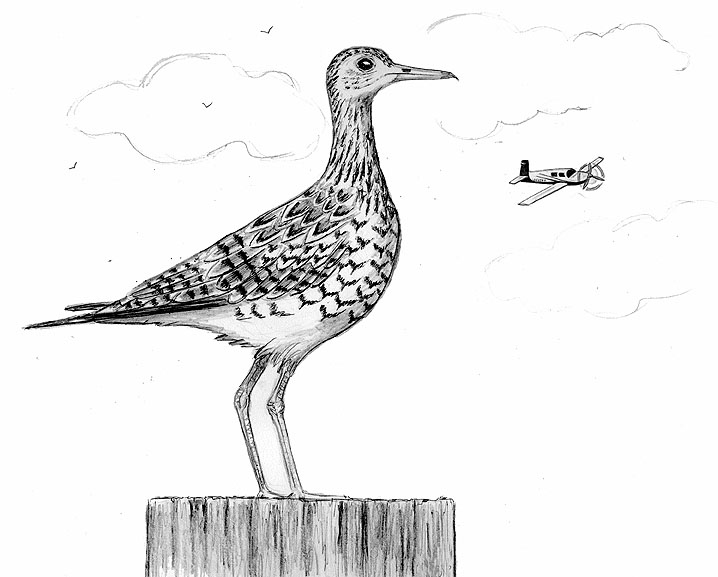
Dear Bird Folks,
The Checklist of the Birds of Cape Cod claims that Upland Sandpipers breed on the Cape, yet I’ve birded around here for years and have never seen one. Where should I be looking?
– Susie, Yarmouth, MA
Good for you, Susie,
Good for you for using the birds of Cape Cod checklist. That list, which has been a measly 95¢ for over thirty years, contains more useful information about local birds than anything ever published, except (of course, for this column). As for the Upland Plovers’ nesting site, I can tell you where it is, but it won’t do you any good. That’s because you aren’t allowed to go there, and neither am I (although, there are lots of places I’m not allowed to go). Where is this forbidden place? I’ll tell you in a minute.
The Upland Sandpiper is the nonconformist of the sandpiper world. Unlike other ‘pipers, they don’t spend their days on the beach, running up and down like idiots, or probing for food in stinky mud. Upland Sandpipers are landlubbers. Instead of mud, they prefer nice dry fields. Unfortunately, these fields are becoming harder to find. Last week I mentioned that Red-bellied Woodpeckers (remember, the one that ate the bat?) are thriving because trees have replaced pastureland. The loss of this habitat, coupled with the old days of market hunting, when thousands of these sandpipers were annually shot and sold for a whopping ten cents each, has resulted in a dramatic decline in their population. In fact, Upland Sandpipers are an endangered species in Massachusetts. Perhaps only four nesting locations exist in the entire state. One of these locations is here on Cape Cod. Yay! But you aren’t allowed to go there…unless you join the Army.
For years the government’s land on the Upper Cape has been known as the Massachusetts Military Reservation. It was a good solid title, but in 2013 somebody decided it should be renamed “Joint Base Cape Cod.” Huh? Anyhow, on the “base” there is an airstrip (Otis, I guess it’s still called), which is surrounded by well-maintained fields. It is on these fields that a few endangered Upland Sandpipers still breed. This is a good place for the birds because their nests are protected by the U.S. Military. But alas, the government doesn’t want birders, or anyone, else nosing around their airbase. Only a few researchers or folks who have jumped through the necessary security hoops are allowed to go bird watching on the base. But don’t worry, Susie, I know of another place where you can see Upland Sandpipers…and you won’t even have to join the Army…unless you want to.
This other location is just a short drive over the bridge to the Plymouth Municipal Airport. Now you might be thinking, “What? Plymouth has an airport?” Right, I didn‘t know about it either. I always thought everyone in Plymouth came and went on the Mayflower. I guess things have changed. The Plymouth Airport not only has good birds, but anyone can go there and they don’t even have to jump through any hoops…well, just one small one. If you decide to look for Upland Sandpipers, or any other birds at the Plymouth Airport, you should first stop and tell the airport manager your plans. It’s mostly a formality, but there could be a time when they would rather not have to deal with birders, such as during their August air show or when Homeland Security is upset about something. The terminal at the airport is a little funky. It looks more like a rural bus station than something you’d see at an airport. Although it does have a very convenient restaurant called, “Plane Jane’s.” (Get it?) On the day I was there the manager wasn’t available, so I spoke with someone else who was very nice and who told me to drive down the road to “Gate 6.” This is where the birders are allowed to look for birds. I thanked him, headed out and was so excited to see Upland Sandpipers I forgot about eating at Plane Jane’s. Oh well, next time.
Basically, birding at this airport is like birding in Gitmo. Many of the best birding areas (the grasslands) are fenced off, which may be annoying but is to be expected. After all, airport officials don’t need a dopey birder like me stumbling around in the middle of the runway. Fortunately, the area isn’t that big and I could easily see most it from outside the fence. The first birds I came upon were a pair of very active Prairie Warblers. As I watched the warblers and their antics, I heard a distinctive “wolf whistle” call. Even though I had never heard an Upland Sandpiper before, I instantly knew what it was. (If there is one thing I know about, it’s wolf whistles.) The call was loud and close by, but no matter how much I scanned the area I couldn’t see any of these tall birds. Where was the call coming from? (I later found out that Upland Sandpipers often call while circling in the air. The bird was actually over my head the whole time and I was totally clueless. See what I mean about being a “dopey birder”?) Finally, the noisy bird landed on a post about twenty feet in front of me and I got a great look at its odd profile. In addition to their signature calls, Upland Sandpipers have long, pencil-thin necks and tiny, round pinheads. If they also had a little acne, they’d look like just about every middle school boy in North America.
I saw several Upland Sandpipers while on my birding trip to the Plymouth Airport, Susie. This is where I think you should look for them, too. Just keep in mind: if you hear a wolf whistle, it’s not coming from me…this time.